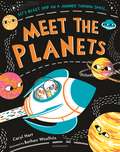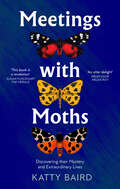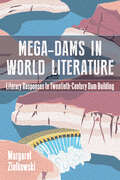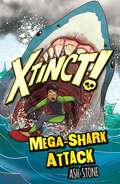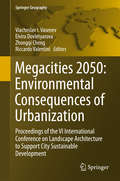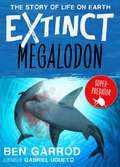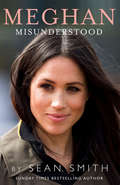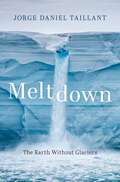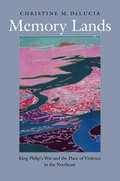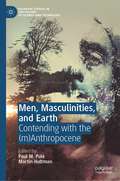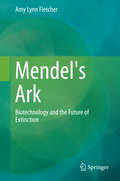- Table View
- List View
Meet the Planets
by Caryl HartZoooooooom! We're off on an exciting space adventure in our rocket to meet all the planets of the solar system.Join in with the rhymes and spot all the smiley-faced, friendly planets, from shimmering Saturn to mighty Mars. Little ones will have a blast (and be back in time for bed!) in this striking, read-aloud, story-led picture book. It's perfect for all would-be astronauts!A special edition where the words and pictures take you on a journey far beyond the page. This audio-enabled eBook comes with a gorgeous reading by Sarah Ovens, along with music and sound effects.
Meet the Weather (Meet the . . .)
by Caryl Hart5, 4, 3, 2, 1 . . . Let's take off! Come on an exciting hot-air balloon adventure and say hello to the different kinds of weather that make up our amazing world!WHOOOOSH! We're off on an exciting adventure in our hot-air balloon to say hello to all the different kinds of weather that make up our world.Join in with the rhymes and get ready to meet everything from whooshing wind to bright rainbows and shimmering sunshine. Little ones will be swept away on an unforgettable journey in this striking, action-packed picture book. This bold, bright follow-up to the acclaimed picture books Meet the Planets and Meet the Oceans is packed with gorgeous illustrations of everything from rainy rainforests to snowy mountains and stormy seas. Combining STEM learning with a rhyming twist, it's perfect for all little meteorologists!
Meetings with Moths: Discovering Their Mystery And Extraordinary Lives
by Katty BairdMossy greens, conker browns, cream, chocolate and deepest black; add stripes, swirls and splotches and you have some of the most striking wildlife Britain has to offer.
Meetings with Remarkable Mushrooms: Forays with Fungi across Hemispheres
by Alison PouliotA whirlwind journey through fungus frontiers that underscores how appreciating fungi is key to understanding our planet’s power and fragility. What can we learn from the lives of fungi? Splitting time between the northern and southern hemispheres, ecologist Alison Pouliot ensures that she experiences two autumns per year in the pursuit of fungi—from Australia’s deserts to Iceland’s glaciers to America’s Cascade Mountains. In Meetings with Remarkable Mushrooms, we journey alongside Pouliot, magnifiers in hand, as she travels the world. With Pouliot as our guide, we smell fire-loving truffles that transform their scent after burning to lure mammals who eat them and, ultimately, spread their spores. We spot the eerie glow of the ghost fungus, a deceptive entity that looks like an edible oyster mushroom but will soon heave back out—along with everything else in your stomach—if you take a bite. And we crawl alongside vegetable caterpillars, which are neither vegetable nor caterpillar but a fungus that devours insects from the inside out. Featuring stunning color photographs of these mycological miracles, Meetings with Remarkable Mushrooms shows that understanding fungi is fundamental for harmonizing with the natural world.
Meetings with Remarkable Mushrooms: Forays with Fungi across Hemispheres
by Alison PouliotA whirlwind journey through fungus frontiers that underscores how appreciating fungi is key to understanding our planet’s power and fragility. What can we learn from the lives of fungi? Splitting time between the northern and southern hemispheres, ecologist Alison Pouliot ensures that she experiences two autumns per year in the pursuit of fungi—from Australia’s deserts to Iceland’s glaciers to America’s Cascade Mountains. In Meetings with Remarkable Mushrooms, we journey alongside Pouliot, magnifiers in hand, as she travels the world. With Pouliot as our guide, we smell fire-loving truffles that transform their scent after burning to lure mammals who eat them and, ultimately, spread their spores. We spot the eerie glow of the ghost fungus, a deceptive entity that looks like an edible oyster mushroom but will soon heave back out—along with everything else in your stomach—if you take a bite. And we crawl alongside vegetable caterpillars, which are neither vegetable nor caterpillar but a fungus that devours insects from the inside out. Featuring stunning color photographs of these mycological miracles, Meetings with Remarkable Mushrooms shows that understanding fungi is fundamental for harmonizing with the natural world.
Meetings With Remarkable Trees (CASSELL ILLUSTRATED CLASSICS)
by Thomas PakenhamThomas Pakenham's beautifully illustrated, bestselling book of tree portraits.With this astonishing collection, Thomas Pakenham produced a new kind of tree book. The arrangement owes little to conventional botany. The sixty trees are grouped according to their own strong personalities: Natives, Travellers, Shrines, Fantasies and Survivors. From the ancient native trees, many of which are huge and immeasurably old, to the exotic newcomers from Europe, the East and North America, MEETINGS WITH REMARKABLE TREES captures the history and beauty of these entrancing living structures. Common to all these trees is their power to inspire awe and wonder. This is a lovingly researched book, beautifully illustrated with colour photographs, engravings and maps - a moving testimonial to the Earth`s largest and oldest living structures.
Mega-Dams and Indigenous Human Rights
by Itzchak KornfeldThis original and insightful book explores and examines the impact that building mega-dams has on the human rights of indigenous peoples living in surrounding areas, who are often significantly affected. It demonstrates the many ways in which human rights are violated by governments and other institutions in relation to large dam projects, and the wider effect this can have on these regions. Compiling case studies from around the world, Itzchak Kornfeld provides clear examples of how human rights violations are perpetrated and compounded, as the construction of and flooding that results from these dams destroys livelihoods, cultural legacies and the local ecology, and promises of resettlement from governments are routinely broken. With chapters examining historical, recent and ongoing dam projects, the book also highlights the involvement of development banks and their failure to respect even their own policies in relation to issues such as environmental impact assessments. This incisive book will be valuable to lawyers, political scientists, and other professionals working in the area of human rights, as well as academics and students. It will also be of interest to those working for government agencies, international organizations, and others involved in dam construction and similar large-scale projects.
Mega-Dams in World Literature: Literary Responses to Twentieth-Century Dam Building
by Margaret ZiolkowskiMega-Dams in World Literature reveals the varied effects of large dams on people and their environments as expressed in literary works, focusing on the shifting attitudes toward large dams that emerged over the course of the twentieth century. Margaret Ziolkowski covers the enthusiasm for large-dam construction that took place during the mid-twentieth-century heyday of mega-dams, the increasing number of people displaced by dams, the troubling environmental effects they incur, and the types of destruction and protest to which they may be subject. Using North American, Native American, Russian, Egyptian, Indian, and Chinese novels and poems, Ziolkowski explores the supposed progress that these structures bring. The book asks how the human urge to exploit and control waterways has affected our relationships to nature and the environment and argues that the high modernism of the twentieth century, along with its preoccupation with development, casts the hydroelectric dam as a central symbol of domination over nature and the power of the nation state. Beyond examining the exultation of large dams as symbols of progress, Mega-Dams in World Literature takes a broad international and cultural approach that humanizes and personalizes the major issues associated with large dams through nuanced analyses, paying particular attention to issues engendered by high modernism and settler colonialism. Both general and specialist readers interested in human-environment relationships will enjoy this prescient book.
Mega-Shark Attack: Book 3 (Xtinct! #3)
by Ash StoneA Megaladon Shark comes back to life in this action-packed adventure story. When Jeevan gets caught in one of Barron Fox's fishing nets, he is pulled into a dangerous underwater adventure. But drowning is the least of his worries. An extinct animal has come back to life in the water ... a megaladon shark! Can Jeevan escape the jaws of the mega-shark and outwit Barron Fox's hunters?Perfect for fans of Beast Quest, Deadly 60 and Jurassic Park, these action-packed adventures will inspire readers to help save endangered species and combat extinction.
Megacities 2050: Proceedings of the VI International Conference on Landscape Architecture to Support City Sustainable Development (Springer Geography)
by Viacheslav I. Vasenev Elvira Dovletyarova Zhongqi Chen Riccardo ValentiniThis interdisciplinary proceedings book addresses highly relevant topics in urbanization and its environmental impacts and presents case studies revealing the negative environmental consequences of the anthropogenic and technogenic pressures. Urbanization is an important trend in current land-use change, with up to 70% of the world population projected to live in cities by 2050. How will this rapid urbanization alter the face of Europe? What are the environmental consequences of the expansion of megacities? These and other important questions are addressed in the Megacities 2050 Proceedings of the VI International Conference on Landscape Architecture to Support City Sustainable Development. Megapolises are complex ecosystems, and their air and water quality, vegetation and soils are exposed to anthropogenic influences. The book discusses advanced approaches and techniques to monitor, model and assess environmental consequences and risks in megapolises and offers solutions to the environmental problems of modern megapolises. It also presents successful, sustainable urban-development projects from Europe and beyond, including the management and design of green infrastructure, waste management, run-off purification and remediation of urban soils. Focusing on urban soils and ecosystems, the book is intended for experts in various fields of geography, urban studies and planning, and environmental sciences, including those in the scientific and research community, municipal services, environmental protection agencies, stakeholders working in urban management and greenery, landscape architects, civil engineers and policy-makers.
Megalodon (Extinct the Story of Life on Earth #6)
by Ben GarrodTV scientist Ben Garrod presents the biggest extinction events ever, told from the point of view of evolution's superstars, the most incredible animals ever to swim, stalk, slither or walk our planet. Whether you're 9 or 90, his unique exploration of the most destructive, yet most creative, force in nature makes top level science fun. Here are the superstars of the story of life, from the super-weird to the super-ferocious. Usually a species has 10 million years or so of evolving, eating, chasing, playing, maybe doing homework, or even going to the moon before it goes extinct.Megalodon, the super-predator, had the most powerful bite force ever measured! Terrorising the oceans, it hunted with stealth and skill, but even Megalodon died out, along with 50 percent of marine mammals, 2.5 million years ago. Find out why!Collect all eight books about animals we have lost in mass extinctions caused by asteroids or mega-volcanoes, clashing continents and climate change.Also includes: * Past brought to full-colour life by palaeoartist Gabriel Ugueto * Ask an Expert contributions from leading scientists * Glossary and pronunciation guide
Meghan Misunderstood
by Sean SmithMeghan Misunderstood is a pioneering book that sets the record straight on the most talked about, unfairly vilified and misrepresented woman in the world.
The Mekong: A Socio-legal Approach to River Basin Development (Earthscan Studies in Water Resource Management)
by Ben Boer Fleur Johns Ben Saul Philip Hirsch Natalia ScurrahAn international river basin is an ecological system, an economic thoroughfare, a geographical area, a font of life and livelihoods, a geopolitical network and, often, a cultural icon. It is also a socio-legal phenomenon. This book is the first detailed study of an international river basin from a socio-legal perspective. The Mekong River Basin, which sustains approximately 70 million people across Cambodia, China, Laos, Myanmar, Thailand and Vietnam, provides a prime example of the socio-legal complexities of governing a transboundary river and its tributaries. The book applies its socio-legal analysis to bring a fresh approach to understanding conflicts surrounding water governance in the Mekong River Basin. The authors describe the wide range of uses being made of legal doctrine and legal argument in ongoing disputes surrounding hydropower development in the Basin, putting to rest lingering caricatures of a single, ‘ASEAN’ way of navigating conflict. They call into question some of the common assumptions concerning the relationship between law and development. The book also sheds light on important questions concerning the global hybridization or crossover of public and private power and its ramifications for water governance. With current debates and looming conflicts over water governance globally, and over shared rivers in particular, these issues could not be more pressing.
The Mekong: A Socio-legal Approach to River Basin Development (Earthscan Studies in Water Resource Management)
by Ben Boer Fleur Johns Ben Saul Philip Hirsch Natalia ScurrahAn international river basin is an ecological system, an economic thoroughfare, a geographical area, a font of life and livelihoods, a geopolitical network and, often, a cultural icon. It is also a socio-legal phenomenon. This book is the first detailed study of an international river basin from a socio-legal perspective. The Mekong River Basin, which sustains approximately 70 million people across Cambodia, China, Laos, Myanmar, Thailand and Vietnam, provides a prime example of the socio-legal complexities of governing a transboundary river and its tributaries. The book applies its socio-legal analysis to bring a fresh approach to understanding conflicts surrounding water governance in the Mekong River Basin. The authors describe the wide range of uses being made of legal doctrine and legal argument in ongoing disputes surrounding hydropower development in the Basin, putting to rest lingering caricatures of a single, ‘ASEAN’ way of navigating conflict. They call into question some of the common assumptions concerning the relationship between law and development. The book also sheds light on important questions concerning the global hybridization or crossover of public and private power and its ramifications for water governance. With current debates and looming conflicts over water governance globally, and over shared rivers in particular, these issues could not be more pressing.
Melanin Base Camp: Real-Life Adventurers Building a More Inclusive Outdoors
by Danielle WilliamsBeautiful, empowering, and exhilarating, Melanin Base Camp is a celebration of underrepresented BIPOC adventurers that will challenge you to rethink your perceptions of what an outdoorsy individual looks like and inspire you to being your own adventure. Danielle Williams, skydiver and founder of the online community Melanin Base Camp, profiles dozens of adventurers pushing the boundaries of inclusion and equity in the outdoors. These compelling narratives include a mother whose love of hiking led her to found a nonprofit to expose BIPOC children to the wonders of the outdoors and a mountain biker who, despite at first dealing with unwelcome glances and hostility on trails, went on to become a blogger who writes about justice and diversity in natural spaces. Also included is a guide to outdoor allyship that explores sometimes challenging topics to help all of us create a more inclusive community, whether you bike, climb, hike, or paddle. Join us as we work together to increase representation and opportunities for people of color in outdoor adventure sports.
Melt
by Ele FountainAn urgent story of adventure and survival in a warming climate, from the multi-award-winning author of Boy 87 and LostYutu lives in a remote, Arctic village with his elderly grandmother. Their traditional way of life is threatened by the changing snow and ice, which melts faster every year.Bea is trying to adapt to yet another new school. Worse still, her father’s new job takes up any spare time, and his behaviour becomes odd and secretive. On a trip she hopes will fix things, their fates take a drastic turn and Bea’s life becomes entwined with Yutu’s in a way she could never have imagined.Together, they are locked in a desperate race for survival.
Meltdown: The Earth Without Glaciers
by Jorge Daniel TaillantWe hear about pieces of ice the size of continents breaking off of Antarctica, rapidly melting glaciers in the Himalayas, and ice sheets in the Arctic crumbling to the sea, but does it really matter? Will melting glaciers change our lives? Absolutely. Glaciers are built and destroyed during ice ages and interglacial periods. These massive ice bodies hold three quarters of our freshwater, yet we don't have laws to protect them from climate change. When they melt, they increase sea levels, alter the Earth's reflectivity, wreak havoc for ocean and air currents, destabilize global ecosystems, warm our climate, and bring on floods that swamp millions of acres of coastal land. The critical ecological role they play to keep our global climate stable, and the environmental functions they provide, wither. And, as climate change warms glacier cores, collapsing glacier ice triggers tsunamis that send deadly massive ice blocks, rocks, earth, and billions of liters of water rushing down mountain valleys. It has happened before in the Himalayas, the Central Andes, the Rockies and Western Cascades, and the European Alps, and it will happen again. In his new book Meltdown, Jorge Daniel Taillant takes readers deeper into the cryosphere, connecting the dots between climate change, glacier melt, and the impacts that receding glacier ice brings to livability on Earth, to our environments, and to our communities. Taillant walks us through the little-known realm of the periglacial environment, a world of invisible subsurface rock glaciers that will outlive exposed glaciers as climate change destroys surface ice. He also looks at actions that can help stop climate change and save glaciers, exploring how society, politics, and our leaders have responded to address the global COVID-19 pandemic and yet largely continue to fail to address the even largerlooming and escalatingcrisis of climate change. Our climate is deteriorating at a drastic rate, and it's happening right in front of us. Meltdown is about glaciers and their unfolding demise during one of the most critical moments of our planet's geological history. If we can reconsider glaciers in a whole new light and understand the critical role they play in our own sustainability, we may be able to save the cryosphere.
Meltdown: The Earth Without Glaciers
by Jorge Daniel TaillantWe hear about pieces of ice the size of continents breaking off of Antarctica, rapidly melting glaciers in the Himalayas, and ice sheets in the Arctic crumbling to the sea, but does it really matter? Will melting glaciers change our lives? Absolutely. Glaciers are built and destroyed during ice ages and interglacial periods. These massive ice bodies hold three quarters of our freshwater, yet we don't have laws to protect them from climate change. When they melt, they increase sea levels, alter the Earth's reflectivity, wreak havoc for ocean and air currents, destabilize global ecosystems, warm our climate, and bring on floods that swamp millions of acres of coastal land. The critical ecological role they play to keep our global climate stable, and the environmental functions they provide, wither. And, as climate change warms glacier cores, collapsing glacier ice triggers tsunamis that send deadly massive ice blocks, rocks, earth, and billions of liters of water rushing down mountain valleys. It has happened before in the Himalayas, the Central Andes, the Rockies and Western Cascades, and the European Alps, and it will happen again. In his new book Meltdown, Jorge Daniel Taillant takes readers deeper into the cryosphere, connecting the dots between climate change, glacier melt, and the impacts that receding glacier ice brings to livability on Earth, to our environments, and to our communities. Taillant walks us through the little-known realm of the periglacial environment, a world of invisible subsurface rock glaciers that will outlive exposed glaciers as climate change destroys surface ice. He also looks at actions that can help stop climate change and save glaciers, exploring how society, politics, and our leaders have responded to address the global COVID-19 pandemic and yet largely continue to fail to address the even largerlooming and escalatingcrisis of climate change. Our climate is deteriorating at a drastic rate, and it's happening right in front of us. Meltdown is about glaciers and their unfolding demise during one of the most critical moments of our planet's geological history. If we can reconsider glaciers in a whole new light and understand the critical role they play in our own sustainability, we may be able to save the cryosphere.
Membrane Transporter Diseases
by Stefan Bröer Carsten A. WagnerEvery cell and organism faces the problem of spaces, made up of the two leaflets of the lipid generating a confined space in which metabolic bilayer. The importance of traffic and signaling across membranes is reflected by the estimate and anabolic reactions take place and at the same time allowing entry and exit of metabo that 20% of all genes in the human genome encode membrane proteins. A failure of any of lites, ions, proteins, and signals across its bor der. Evolution has solved the problem by these proteins may have dramatic con se generating lipid membranes that contain trans quences for ceH function. In recent years much porters, ion channels, and receptors. In eukary attention has been paid to diseases resulting otic cells, this problem is exacerbated by the from nonfunctional ion channels ("chan presence of multiple organelles, which are con nelopathies"). Not surprisingly, many of these fined spaces in their own right. Even the lipid diseases affect the excitability of cells. membrane consists of two relatively separate Transporter diseases (perhaps coined "carrier vi PREFACE diseases") are more related to metabolic dis Each chapter is concluded by a summary, and eases, Transporters are frequently found at the most chapters also contain an overview of the beginning or the end of metabolic pathways clinical features of a particular transporter and as a result can have similar effects to disease. a missing enzyme.
Memory and Fabrication in East Asian Visual Culture: Ruinous Garden (Routledge Contemporary Asia Series)
by Dennitza GabrakovaThis book examines four contemporary sites of visual culture in East Asia through the poetic prism of the “ruinous garden.” Framing destroyed, discarded, and displaced material objects within a rhetoric of development and relating this to the experience of ethnic/national culture, the book presents succinct analyses of visual works, as well as cultural criticisms, centered on space in metropolitan Japan and Hong Kong, China. These analyses are placed in dialog with approaches from postcolonial texts, addressing development and fractures in representation. Additionally, the book suggests graphic design as a form of retrospective cultural thinking, encompassing visual and invisible modernity, as well as an attachment to disappearing space. Offering a unique and thorough analysis of Japanese visual culture, combining discussion on photography, installation art, and graphic design, as well as integrating material from Hong Kong visual culture in discussions of identity, this book will appeal to students and scholars of visual culture in East Asia, environmental art, and environmental humanities.
Memory and Fabrication in East Asian Visual Culture: Ruinous Garden (Routledge Contemporary Asia Series)
by Dennitza GabrakovaThis book examines four contemporary sites of visual culture in East Asia through the poetic prism of the “ruinous garden.” Framing destroyed, discarded, and displaced material objects within a rhetoric of development and relating this to the experience of ethnic/national culture, the book presents succinct analyses of visual works, as well as cultural criticisms, centered on space in metropolitan Japan and Hong Kong, China. These analyses are placed in dialog with approaches from postcolonial texts, addressing development and fractures in representation. Additionally, the book suggests graphic design as a form of retrospective cultural thinking, encompassing visual and invisible modernity, as well as an attachment to disappearing space. Offering a unique and thorough analysis of Japanese visual culture, combining discussion on photography, installation art, and graphic design, as well as integrating material from Hong Kong visual culture in discussions of identity, this book will appeal to students and scholars of visual culture in East Asia, environmental art, and environmental humanities.
Memory Lands: King Philip’s War and the Place of Violence in the Northeast (The Henry Roe Cloud Series on American Indians and Modernity)
by Christine M. DeLuciaNoted historian Christine DeLucia offers a major reconsideration of the violent seventeenth-century conflict in northeastern America known as King Philip’s War, providing an alternative to Pilgrim-centric narratives that have conventionally dominated the histories of colonial New England. DeLucia grounds her study of one of the most devastating conflicts between Native Americans and European settlers in early America in five specific places that were directly affected by the crisis, spanning the Northeast as well as the Atlantic world. She examines the war’s effects on the everyday lives and collective mentalities of the region’s diverse Native and Euro-American communities over the course of several centuries, focusing on persistent struggles over land and water, sovereignty, resistance, cultural memory, and intercultural interactions. An enlightening work that draws from oral traditions, archival traces, material and visual culture, archaeology, literature, and environmental studies, this study reassesses the nature and enduring legacies of a watershed historical event.
Men, Masculinities, and Earth: Contending with the (m)Anthropocene (Palgrave Studies in the History of Science and Technology)
by Martin Hultman Paul M. PuléThis book considers issues of social and ecological significance through a masculinities lens. Earth – our home for aeons – is reeling. The atmosphere is heating up, causing reefs to bleach, fisheries to collapse, regions to flood and dry, vast tracts to burn, the polar ice caps to melt, ancient glaciers to retreat, biodiversity to decline exacerbated by the sixth great extinction, and more. Meanwhile, social and economic disparities are widening. Pandemics are cauterising glocal communities and altering our social mores. Nationalism is feeding divisiveness and hate, especially through men’s violence. Politically extreme individuals and groups are exalting freedom while scapegoating the marginalised. Such are the symptoms of an emerging (m)Anthropocene. This anthology contends with these alarming trends, pointing our attention towards their gendered origins. Building on our monograph Ecological Masculinities: Theoretical Foundations and Practical Guidance (2018), this collection of essays is framed as a dinner party conversation grouped into six discursive themes. Their views reflect a growing community of practice, whose combined efforts capture the most recent perspectives on masculine ecologisation. Together, they aim to help create a more caring world for all, moving the ecological masculinities conversation forward as it becomes an established, international, and pluralised field of study.
Mendel's Ark: Biotechnology and the Future of Extinction
by Amy Lynn FletcherDoes extinction have to be forever? As the global extinction crisis accelerates, conservationists and policy-makers increasingly use advanced biotechnologies such as reproductive cloning, polymerase chain reaction (PCR) and bioinformatics in the urgent effort to save species. Mendel's Ark considers the ethical, cultural and social implications of using these tools for wildlife conservation. Drawing upon sources ranging from science to science fiction, it focuses on the stories we tell about extinction and the meanings we ascribe to nature and technology. The use of biotechnology in conservation is redrawing the boundaries between animals and machines, nature and artifacts, and life and death. The new rhetoric and practice of de-extinction will thus have significant repercussions for wilderness and for society. The degree to which we engage collectively with both the prosaic and the fantastic aspects of biotechnological conservation will shape the boundaries and ethics of our desire to restore lost worlds.
